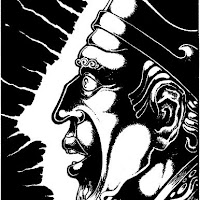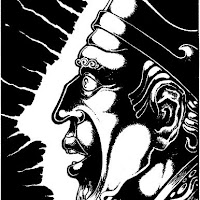I'm going to try something new this time and compare two similar game books. Both are descendants of the
Advanced Fighting Fantasy game rules, or what, these days, we might call
troikalike games.
Secrets Under Stone, written by N Weaver with a print edition by
Soul Muppet, is listed as the first issue of a recurring zine called
Deep Under Stone, although no second issue has been released yet, and the proposed structure of the zine series suggests that Weaver intends
Secrets to stand alone as a complete game book. As proposed, future issues will apply the same mechanics to different settings. The art is from the public domain, including the cover collage.
Secrets Under Stone is set in a general British Gothic milieu, sometime in the
Long Nineteenth Century. The setting
is a departure from the other
troika-likes, but it should seem familiar to anyone who has encountered Gothic tropes before. The primary innovations that separate
Secrets from its sister games are mechanical, so those will get the majority of my attention.
One of the most common complaints I've heard about
Troika is the random starting Skill score. In
Troika, you roll 2d6+12 to determine Stamina, 1d6+6 to determine Luck, and 1d3+3 to determine Skill. These roughly correspond to Hit Points, Saving Throws, and Skills, respectively, in
D&D. This looks really elegant when written out, but it means that about a third of characters have Skill 4, and thus
only a 16.67% chance - the same as 1-in-6 - to accomplish any task that they don't specifically have an Advanced Skill in. You may recall me mentioning before that Old School designers love giving 1-in-6 and 2-in-6 chances for starting characters to accomplish things they are ostensibly good at, and that Old School players love to complain about how miserly and miserable they find these chances. Elegance on paper is not the same thing as a mechanic that players will enjoy using at the table.
So it was a pleasant surprise for me to see that Secret Under Stone's primary mechanical innovation is to change the Skill mechanic by splitting it in three. Players roll to determine six Advanced Skills from across three categories - Brawn, Knack, and Knowledge. Each of those acts as a base Skill score for those areas of character ability, and each is 4 plus half the number of Advanced Skills. So scores as low as 4 and as high as 7 are possible but unlikely - most scores will be 5 or 6 - but low scores in one area will be automatically offset by higher scores in the others. Instead of the colorful Backgrounds from Troika, the nature of your character is determined by the mix of these skills.
To transplant the basic skill mechanic introduced here to another rules system besides those derived from
Advanced Fighting Fantasy would take a bit tinkering, but it would be far from impossible. The basic mechanic is randomly selecting special skills and then using the total number of each
type of those skills as the basis to generate ability scores. The first thing I was reminded of was
Empire of the Petal Throne, where player rolled to generate ability scores and then received skills in order from a list based on how high their score is. That mechanic is essentially the inverse of
Secret Under Stone's, and it's easy to imagine a contemporary take on
Tekumel that used the mechanic introduced here. Another possibility is
Numenera, which has pre-set ability scores by character class, and player-selected special skills that draw on those abilities. Once again, reversing and randomizing to use
Secret's mechanic is easy to envision.
The other aspect of the Skill mechanic here that I really like is that each skill comes with a piece of starting equipment that uses it. I've mentioned on my own blog that
skills in D&D and most other tabletop roleplaying games require a kind of two-factor authentication - you need both the skill and the equipment to actually do something. Thieves need lockpicks, bards need music instruments, clerics need holy symbols, etc.
(There are some counter-examples, where you need just one or the other but not both, but for this review the trend is more important than the exceptions.) Depending on the version of the game you're playing, characters might be gifted these tools automatically upon picking their class, or the rules might rely on player skill to buy the right starting equipment. Here there are no character classes, only skills, but if you're good at climbing, you get a rope; if you know how to swordfight, you start with a sword. Combine this with something similar to
the weapon-specific abilities I praised in my review of Root, and I think you could really have something interesting, something I'd like to see more of in other games.
An example character in Secrets Under Stone might start with Axe Fighting, Sword Fighting, Crossbow Shooting, Navigation, Astrology, and Spiritualism, Brawn 5, Knack 5, Knowledge 5, and own an axe, a sword, a crossbow with 20 bolts, a compass, an astrolabe, and a spirit board. Despite the lack of a named Background, it's relatively easy to imagine this character within a broadly Victorian milieu - an explorer perhaps, equally attuned to the practical and supernatural properties of the night sky, and ready to hack through underbrush and opposing forces alike.
The magic system and bestiary of Secrets both feel incomplete, and there is essentially no worldbuilding beyond what is implied by character creation, and no real advice about how to run an adventure using these rules, either in general or with an eye toward distinguishing it from its sister games. Astrology and Spiritualism, for example, are both skills that grant your character the ability to use magic, and there are about a half-dozen others that do the same. Weaver suggests that instead of Troika's spells, Secrets characters with the correct skills should be able to learn Rituals. The key differences appear to be that rituals are intended to seem more low fantasy than spells; they each have success, critical success, failure, and critical failure results; and there is no indication in the text how, or even if, the number of rituals a character might learn from each skill should be limited. Weaver has written two rituals for each spellcasting skill, and left the rest of the hard work of developing setting-appropriate magical effects with four levels of efficacy each to the referees who volunteer to use this new system.
Magic can also be acquired by bonding with a Patron. These work quite similarly to patrons in Dungeon Crawl Classics. There is a well described ritual for forming a bond, with the Secret-standard four levels of effect. Each patron grants a Boon, a situational bonus that depends on the character's skill level, and knowledge of three Powers, which function exactly like normal spells in Troika, including the variable Stamina costs, and which mirror the three Patron Spells in DCC, Each patron also has a 1d6 table of Curses, which also mirror the Patron Taint effects in DCC. The levels of effectiveness are another similarity, now that I think of it. For the nine spellcasting skills, Weaver has provided two example patrons, leaving the other seven for interested referees to invent for themselves. I would be more forgiving if the anticipated second issue of the zine were intended to complete these rules rather than provide a palette swap into another new setting. I am interested in seeing the new setting, but this one still feels incomplete in certain key respects.
The bestiary is primarily made up of creatures referenced in other parts of the book. The mundane animals you might receive as "equipment" if you have the animal handling skill are here, as are the various servitors and familiars you can create with one of the listed magic rituals, and the mercenaries of varying quality you can hire to accompany you. I am gratified that there are no creatures referenced earlier that don't get an entry, but the lack of other entries feels like a missed opportunity to me. First because of the lost chance to expand the Secrets world, and second because Weaver has chosen to alter the math of Troika's combat by reducing weapon damage, dropping Stamina by half - from 2d6+12 to 2d3+6 - and replacing the "playing card initiative" with the standard D&D style alternating combat. Taken all together, I'm not certain what effect all those changes have on the pace of combat, but I am sure that you can't simply drop a monster from Troika into a Secrets Under Stone game without it tearing through the weaker characters like a wrecking ball. So some additional sample opponents would be helpful for preparing an appropriate adventure. The one saving grace is the addition of a kind of Luck check - another transplant from DCC! - that possibly allows surviving a fall to 0 Stamina.
Weaver concludes with a page and a half of advice about how to run adventures that incorporate investigation and the learning of new magical Rituals, and a couple pages of advice and encouragement for altering the rules to fit another setting. The most cryptic advice is from a page on the possible rewards characters might receive from adventuring - Luxury, Prestige, and Conscience. Weaver provides a list of milestone achievements, and the reward, in points, for meeting each milestone. These points do not interact with any system of experience or advancement. As Weaver explains: "This page allows you to quantify your achievements, which provides no reward beyond the pleasure of doing so. Think of it like a High Score table or ignore it entirely."
Azag is described as a complete game book, although as I understand it, a print edition with more art might eventually be forthcoming. It's published by
Dank Dungeons with a print edition by
LF OSR, and written primarily be Lex Mandrake, with additional text by Chris Boudreau, Diogo Nogueira, Safia Aldulaijan, and Mahar Mangahas. The cover art is by Luis Melo, with interior art by Logan Stahl, and maps by Daniel Walthall. The additional authors supplied short fiction about the setting; I'm not certain if they wrote any of the game material.
Azag makes some minor mechanical departures from the other troik-alikes, but here the majority of the authors' effort has been poured into creating an original setting, so again, I'm going to put most of my attention where the action is.
The opening sections of Azag start with a short story; an overview of the rules for skills, combat, and traveling; a second short story; the rules for character creation and advancement; a third short story; a section on Talents - which are Azag's version of Troika's Advanced Skills - and spells; a fourth short story; lists of equipment and tables for generating magic items; a fifth short story; and then we enter the much longer second half of the books, which is all about the unique setting of the game.
I will leave it to someone more qualified to comment on the style and content of the short stories, but I will note that each is only a page long and is accompanied by a full-page piece of art. They effectively act as section breaks between the steps of character creation. My one critique of this organization is that the sections are placed in the reverse of the order that they're listed as steps of character construction. Azag also declines to list character Backgrounds, and instead asks players to generate characters by combining the results from several lists. Following the instructions, you're supposed to start with a magic item, then receive mundane equipment, then pick Talents and spells, and finally write three unique Traits. In keeping with the reverse order of the other sections, the advice for that last step are right below the instructions for the character creation process.
Like Secrets Under Stone, the Talents in Azag are closer to D&D's skill list than to the more outre options found in Troika. You Talents might include Reflexes or Willpower; Ranged Weapons or Armor Specialist; or something like Awareness, Stealth, Lockpicking, or Wayfinding. Weapon damage is also based on different sizes of dice, like D&D and unlike Troika's bespoke damage tables that transform the effects of rolling a d6.
Magic items are the one element of character creation that's random instead of chosen by the player. To create one you roll 2d12 three times to determine the
Item Type,
Prefix, and
Suffix. So you might end up with the
Bronze Gemstone of Might, which increases your Skill and makes Tests of Strength easier, or the
Silver Sword of Luck, which increases your Stamina and causes you to gain and lose Luck points when you pass and fail Luck Tests, amplifying their swingy-ness. It's clear that Mandrake has considered
the distribution of possible results, and has pushed both the rarer sounding names and the more impressive looking powers away from the center and toward the edges of the probability curve.
The second half of Azag is devoted to describing its game world. The organization of this section is very nice. First, a page listing the four regions of the world, with a one-sentence description of each, and a list of a half-dozen or so important locations in that region. There are the Coin Roads, a desert crossed by trade routes, the Crescent Sea, a Mediterranean coastline, the Shadow of the Great Glacier, a wintry northern region, and the Verdant Basin, a tropical jungle.
Next, two to a page, each evocatively named location gets a paragraph description and a d6 table of possible encounters. These act more like storytelling prompts than like traditional D&D encounters. This section, if used as written, probably plays out much more like a storygame than like any other version of Advanced Fighting Fantasy, they contain both a setup and a conclusion and ask the reader to decide how the characters got from one to the other. The prompts could also be used differently than suggested, by a referee preparing ahead of time, as the starting point for more traditional roleplaying. One prompt in the Alabaster Maze in the Coin Roads region suggests "You became hopelessly lost in the labyrinth with no chance of escape. A being in the form of an albino bat offered to guide you out of the maze for a price. What did the bat ask of you?" Another, from the Invisible Library of Malazar along the Crescent Sea tells "Warlocks from distant lands offered you riches for escort through the library. When they found the text they sought you were betrayed and had to fight your way out. What knowledge had driven them to kill and how did you best them?"
Used as written, these encounters presume a conclusion that might otherwise take an entire game session to achieve, if it could be won at all, and invite the players and referee together to retroactively decide how this was accomplished. I can imagine relying on the character's Talents and Spells and magic items to tell the story of how they escaped the maze or defeated the warlocks, but it doesn't seem like any of the previous mechanics of rolling dice should be involved. The dice help us decide the success or failure of something we attempt. Here the success is already decided, only the method used to achieve it has yet to be played out.
Ryuutama uses similar mechanics, though on a
much smaller scale, rolling the dice first, then asking, for example, how you got injured along the trail, or what happened in the night to disturb you sleep so.
After another short story, the next section is devoted to the NPCs you might meet while adventuring. There is a table for each region to generate NPCs. Roll a d6 three times to discover their Background, Motivation, and Unique Trait, though with only six traits per region, they aren't really so unique, and then consult the table of Plot Hooks. There are 36 possible plot hooks in each region, each determined by the NPC's background and motivation. For example, in the Great Glaciers, you might meet a mammoth herder who is obsessed with getting their deity to the best shrine in Barbasdu, you might discover that "Haunted by dreams of a mammoth-headed deity taller than the Great Glacier, they now believe the shrines of Barbasdu to be the rightful grazing ground of the magnificent beasts. These woolly giants will be mounted and ridden to the gates of the city to take their rightful home." Or in the Verdant Basin, you might find a basking cultist who wants to prove their innocence before their people, about whom you learn that "This cultist's jilted ex-lover has accused them of worshiping the Moon King. To prove their loyalty, they must climb to the top of smouldering Mt. Kirmak in the Frostfire Peaks and retrieve a perfect sunbleached opal."
The plot hooks are really what make these characters unique, and I think that Mandrake has given each an agenda that goes beyond, in both richness and specificity, what most referees might be able invent for themselves just from looking at the backgrounds and motivations. Each NPC holds the seed to an adventure, complete with locations, items, other NPCs. These seeds are the primary source of inspiration for running adventures in the world of Azag. Most adventures then, are likely to start with the players meeting someone with their own agenda, and deciding whether to assist them, thwart them, or otherwise take advantage of the conditions that agenda will create.
The final section, separated by a last short story, offers roughly 20 new monsters, each with a pair of abilities or interesting details. The creatures Mandrake has chosen seem consistent with his stated goal of building a game world similar to the stories of Clark Ashton Smith, and they seem appropriate to a world of harsh desert and dense jungle. There are several varieties of undead, giant insects, dinosaurs, and mechanical servitors. Ironically, what's missing here is a few examples of mundane or human opponents to provide a baseline chassis for the sorts of cultists, nomads, and magicians that show up in the encounter tables and NPC plot hooks.













